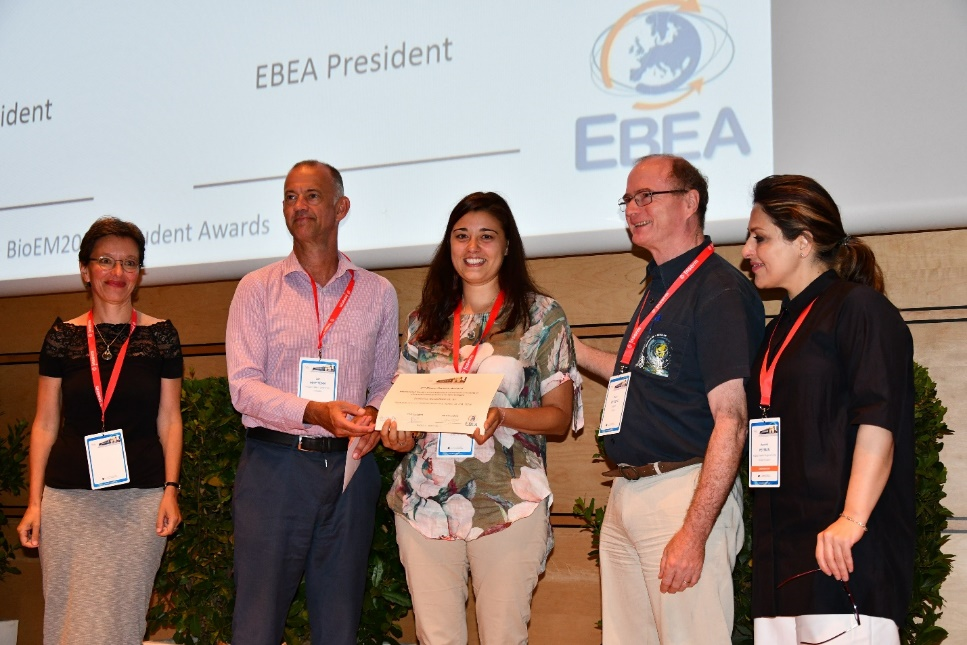Authored by: Azadeh Peyman
Published on: Jul 26, 2019
The BioEM2019 students’ awards for best platform and poster presentations were given to the following students:
Platform Presentation Awards
1st place and the winner of Joseph James Morrissey Memorial Award*: Micol Colella
2nd place: Jasmina Wallace
3rd place: Yoann Meriguet
*The Joseph Morissey Memorial Award, is sponsored and awarded by the MMF, represented by Antonio Faraone.
Poster awards
1st place: Mauro David
2nd place: Alanna Van Huizen
3rd place: Federica Castellani
The BEMS and EBEA award committees, would like to extend their appreciation to all the judges and reviewers and many congratulations to all student winners. As it is customary this year’s winners have also provided to a brief note, about their research work and experience at the BioEM2019 meeting.
Azadeh Peyman and Anke Huss (BEMS and EBEA Award Chairs)
Award winners report about their research and experience at BioEM2019
Micol Colella
1st Place Platform Award & Winner of Joseph James Morrissey Memorial Award
A µTMS coil for ultra-focal noninvasive magnetic stimulation
Micol Colella et al.
Electronics and Telecommunications (DIET), University of Rome “La Sapienza”, Rome, Italy
I’m a PhD student in Information and Communication Technology (curriculum of Electronics) at the University of Rome “La Sapienza”, where I’ve also earned my bachelor degree in Clinical Engineering and my master’s degree in Biomedical Engineering. Currently, I’m carrying out my research in the bioelectromagnetic lab under the supervision of Micaela Liberti. The main focus of my PhD project is the numerical modeling of electric and magnetic noninvasive brain stimulation techniques. Particularly, the aim is to conduct the dosimetric analysis of such techniques in order to estimate the induced electromagnetic quantities and correlate this result with the clinical outcome. Morever, a computational dosimetric study helps investigate the several sources of variability that can influence the electric field distribution induced by noninvasive brain stimulation techniques.
At the BioEM 2019 meeting I presented the numerical model of a newly developed miniaturized coil for transcranial magnetic stimulation (TMS). This coil was conceived and manufactured by Prof. Giorgio Bonmassar and his research group, at the Martinos Center for Biomedical Imaging in Boston, where I had the great opportunity to work as a graduate research assistant. The ability of such coil to elicit neuronal stimulation has been demonstrated on the peripheral nervous system with experiments on human volunteers. Thus, this computational study helped predicting the outcome of the experiments and estimating the stimulation threshold of the stimulated nerve.
I would like to thank the BioEM 2019 organizers for their hard work, thanks to which we all had the opportunity to attend a great conference, filled with interesting topics and esteemed researchers. The city of Montpellier gave the opportunity to relax and chill in great company after a long day full of science. This is the very first BioEM meeting I’ve ever attended and I couldn’t expect anything better, which makes it even a greater honor for me to have received the 1st Place Platform Award and the Joseph James Morrissey Memorial Award.

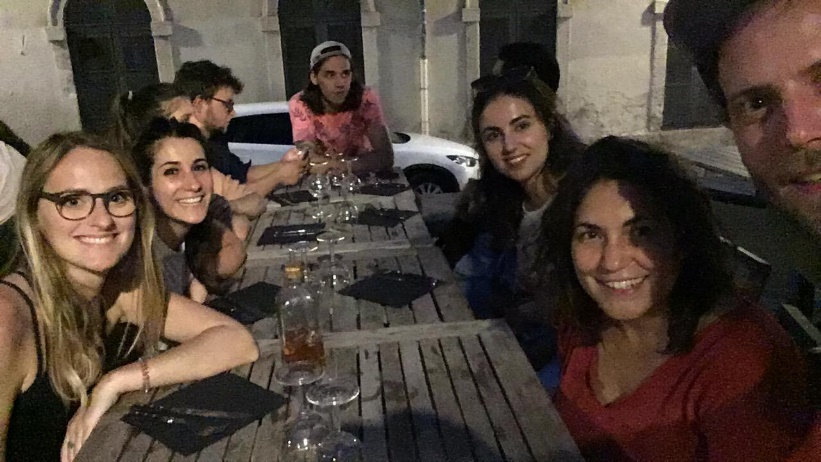

Jasmina Wallace
2nd Place Platform Award
Effect of exposure to 900 MHz radiofrequency on the MEG alpha band activity at rest
Jasmina Wallace et al.
Institut National de l'Environnement Industriel et des Risques (INERIS), Verneuil-en-Halatte, France
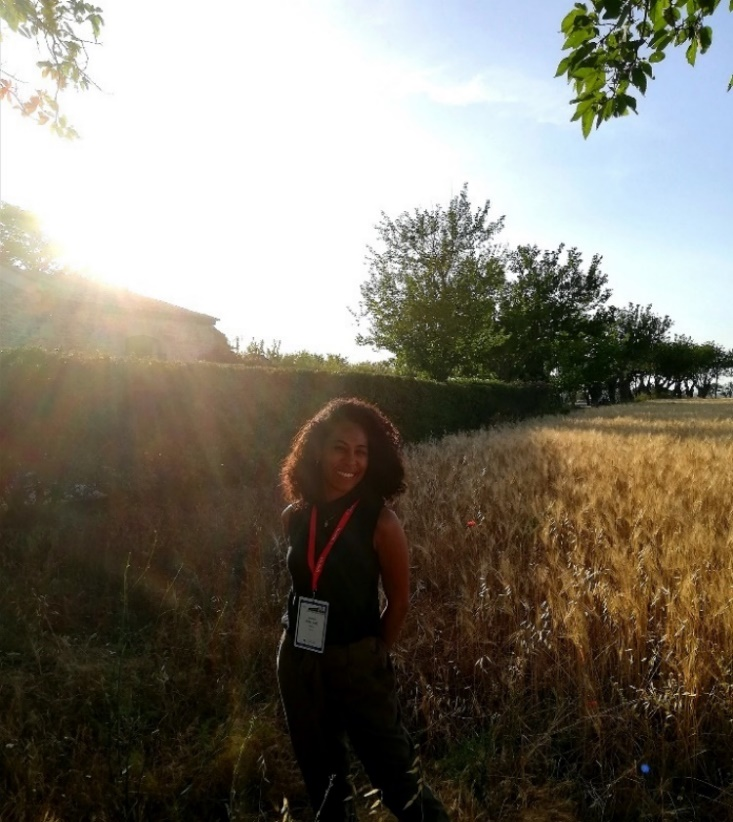 I graduated from University Alma Mater Studiorum of Bologna (Italy) in 2016 and I majored in Health Biology. During my master studies I became interested in electrophysiology and public health. So, I am currently pursuing my doctorate in Human Physiology at the Experimental Toxicology Unit of the French National Institute for Industrial Environment and Risks (INERIS, Verneuil-en-Halatte) and the Peritox laboratory (University of Picardy, Amiens).
I graduated from University Alma Mater Studiorum of Bologna (Italy) in 2016 and I majored in Health Biology. During my master studies I became interested in electrophysiology and public health. So, I am currently pursuing my doctorate in Human Physiology at the Experimental Toxicology Unit of the French National Institute for Industrial Environment and Risks (INERIS, Verneuil-en-Halatte) and the Peritox laboratory (University of Picardy, Amiens).
The BioEM2019 in Montpellier was my second BioEM congress, where I presented a platform presentation outlining the results of my Ph.D. project. My research focuses on the effects of radiofrequency electromagnetic fields related to mobile phones on the human brain activity at rest. Even if several previous studies investigated electrophysiological modifications related to radiofrequency exposure by electroencephalography, there are still inconclusive results. For this reason, I study radiofrequency effects on spontaneous brain activity oh healthy volunteers with electroencephalography and magnetoencephalography combined with an anatomical MRI. This protocol approach, realised for the first time in this field to my knowledge, assures a higher spatial resolution, compared to previous electroencephalography studies.
I really enjoyed the conference with its varied scientific program and experts working on different bioelectromagnetic topics. It was a great and valuable scientific experience and a perfect opportunity to share knowledge and ideas in a friendly atmosphere. It was an exceptional honor for me to have received the 2nd Place Platform Award at such an event.
Moreover, thanks to this experience I could discover the city of Montpellier, with beaches, wheat fields and pink flamingos just around the corner, I really loved it!
I would like to thank the BioEM2019 committee for organizing the conference and providing me the student travel support. And last, but not least, I would like to thank my thesis director Dr. Brahim Selmaoui for his continuous support and all collaborators for all the work provided on this project.
Yoann Meriguet
3rd Place Platform Award
Collective oscillations of proteins proven by terahertz spectroscopy in aqueous medium
Yoann Meriguet et al
Institut d'Electronique et des Systèmes (IES), University of Montpellier, Montpellier, France
I am a second year PhD student within the Terahertz group at Charles Coulomb Laboratory and Institute of Electronic and Systems at University of Montpellier, France. I am currently doing research on interactions between proteins. More precisely, the goal is to prove that when we put the proteins out of equilibrium, collective oscillations of these proteins take place, leading to interactions between each other. The associated resonances are expected into the terahertz frequency range. It is an exciting subject, combining my background as a physicist with the field of biology that has always attracted me.
BioEM2019 in Montpellier was my first international conference. It gives me the great opportunity to present our research to renowned researchers with whom I was able to have exciting discussions. I would thank again the BioEM2019 committees for organising this great conference and for sponsoring my registration. I hope to be able to participate next year and see the very interesting platforms, plenaries and posters sessions again.

David Mauro
1st Place Poster Award
Dosimetric analysis of hands exposure during handling of strong permanent magnets
Mauro David et al.
UAS Technikum Wien, Vienna, Austria
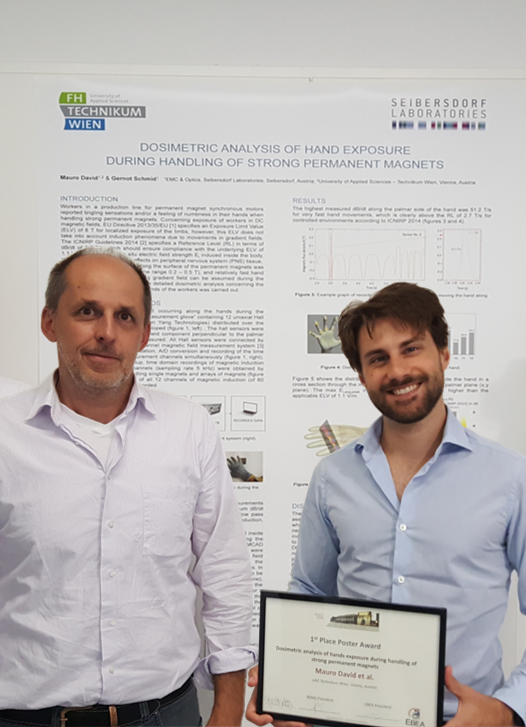
I just finished my Masters degree in Biomedical Engineering at the University of Applied Sciences Technikum Wien, but originally I am from Italy, where I did my bachelor in Electronic Engineering at the Polytechnic University of Milano. During my last year of the master program, I had the possibility to work one year at Seibersdorf Laboratories, which sponsored my research, focused on a dosimetric analysis of hands exposure during handling of strong permanent magnets. Indeed, workers in a production line of synchronous motors, reported the feeling of numbness and tingling sensations in their hands while handling strong permanent magnets. Therefore, we decided to perform numerical simulations of the induced electric field inside the hands, using a high-resolution anatomical model of the hand developed for the project.
BioEm 2019 in Montpellier was a truly extraordinary experience, and it was an honor and a pleasure to win the 1st place in the Student Poster Competition. I am very grateful for having received the possibility to participate in the conference, which gave me the opportunity to get to know amazing people of the community and to learn about the new research that is ongoing in this field.
My contribution to the conference would not have been possible without the support of my supervisor and the co-author of the poster, Gernot Schmid. I am very thankful for his help and advice.
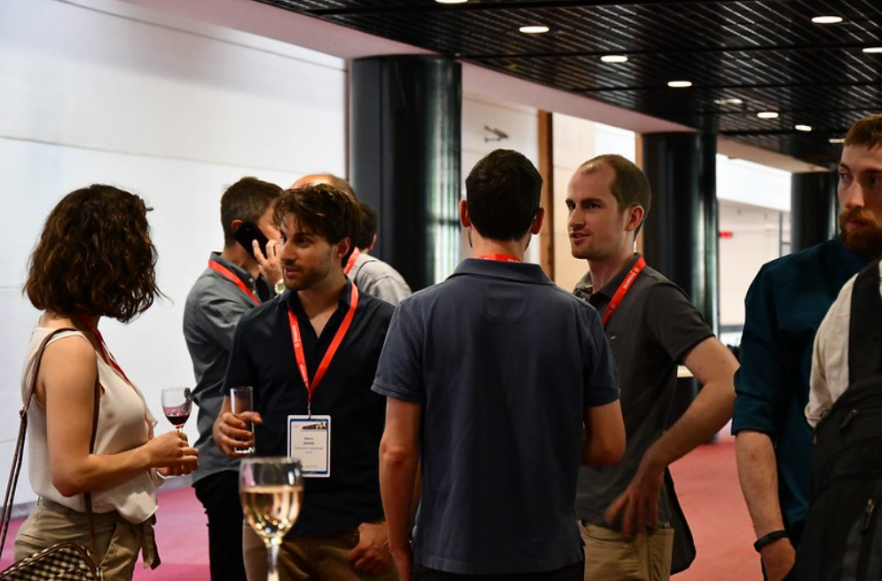
Alanna Van Huizen
2nd Place Poster Award
Manipulation of weak magnetic fields alters stem cell proliferation during regeneration
Alanna Van Huizen et al.
Department of Biological Sciences, Western Michigan University, Kalamazoo, Michigan, USA, 49008-5410
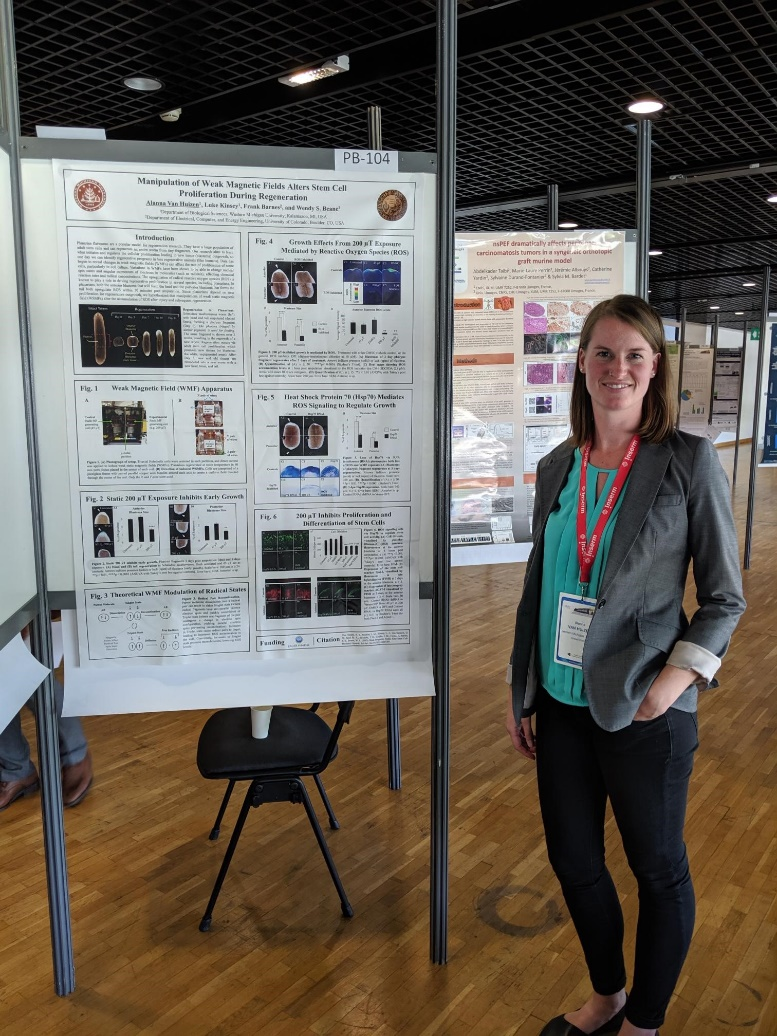 I am a PhD candidate in the biological sciences at Western Michigan University working in the Beane lab. My research focuses on the effects of static weak magnetic fields on stem activity during regeneration in the planarian, a small flatworm capable of regenerating all of its tissues. My research suggests that exposure to 200 microtesla during regeneration inhibits normal growth by blocking normal reactive oxygen species (ROS) accumulation that drives regeneration. Lack of ROS accumulation results in reduced gene expression, reduced proliferation of stem cells, and fewer cells differentiating.
I am a PhD candidate in the biological sciences at Western Michigan University working in the Beane lab. My research focuses on the effects of static weak magnetic fields on stem activity during regeneration in the planarian, a small flatworm capable of regenerating all of its tissues. My research suggests that exposure to 200 microtesla during regeneration inhibits normal growth by blocking normal reactive oxygen species (ROS) accumulation that drives regeneration. Lack of ROS accumulation results in reduced gene expression, reduced proliferation of stem cells, and fewer cells differentiating.
BioEM 2019 was a wonderful experience for me as it gave me the opportunity to share my work with people who have similar research interests. I felt stretched by the 3-minute talk exercise, as it pushed me to concisely describe my findings in an understandable way. During the poster session I had great conversations with many people who brought new ideas, questions and insights to my work. Similarly, listening to the presentations of other researchers allowed me to learn much more about methods and made me think of how my own work might connect. I went home with some new directions to explore and questions to pursue!
I want to thank BioEM for funding my conference attendance and allowing me to have this opportunity. I was extremely honored to win second place in the poster competition. I also want to thank my advisor, Dr. Wendy Beane for guiding me through this work and giving me opportunity to share it with others. Lastly, I’d like to thank my collaborator, Dr. Frank Barnes who has made all of this work possible.
Federica Castellani
3rd Place Poster Award
Microsecond kinetics of ion transport and interface binding in electrically stressed phospholipid Bilayers
Federica Castellani et al.
Frank Reidy Research Center for Bioelectrics, Norfolk, Va, USA, 23508
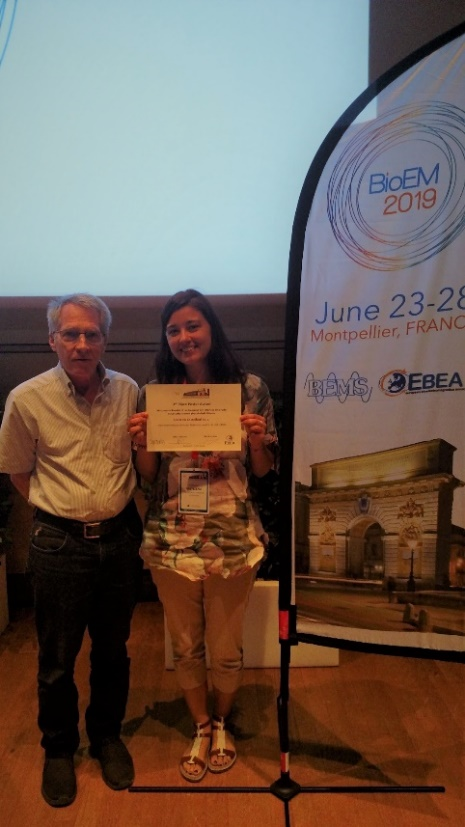 I am a Ph.D. student in Biomedical Engineering at the Batten College of Engineering and Technology at Old Dominion University in Norfolk, Virginia, USA, carrying out my doctoral research in Tom Vernier’s laboratory at the Frank Reidy Research Center for Bioelectrics . I am originally from Italy, where I earned a bachelor of science degree in Chemical Engineering and a master’s degree in Nanotechnology Engineering at La Sapienza University of Rome. My research is focused on molecular dynamics MD simulations of ion transport through electrically stressed phospholipid membranes. MD is a “microscope” that enables the study of the nanoscale evolution of physical and chemical systems, including complex processes that take place in biomolecular systems that are not observable with conventional experimental methods.
I am a Ph.D. student in Biomedical Engineering at the Batten College of Engineering and Technology at Old Dominion University in Norfolk, Virginia, USA, carrying out my doctoral research in Tom Vernier’s laboratory at the Frank Reidy Research Center for Bioelectrics . I am originally from Italy, where I earned a bachelor of science degree in Chemical Engineering and a master’s degree in Nanotechnology Engineering at La Sapienza University of Rome. My research is focused on molecular dynamics MD simulations of ion transport through electrically stressed phospholipid membranes. MD is a “microscope” that enables the study of the nanoscale evolution of physical and chemical systems, including complex processes that take place in biomolecular systems that are not observable with conventional experimental methods.
My presentation at the BioEM 2019 showed that strong transmembrane electric fields promote the formation of bilayer-spanning water bridges and conductive lipid pores through which drugs, nucleic acids, and other normally impermeant material can enter cells. The mechanisms underlying this process, called electroporation, are not well understood. We investigate this phenomenon with molecular simulations of lipid membranes in electric fields at the experimentally inaccessible nanoscale. Here we describe the previously unexplored microsecond kinetics of ion binding to phospholipid bilayers and transport through lipid electropores in double bilayer systems containing K+, Ca2+, and Cl-.
The dynamic intracellular distribution of Ca2+ is a key component in the operation of numerous regulatory and signaling pathways. During and after membrane permeabilization, Ca2+ is electrically and diffusively driven into the cell by the transmembrane electric field and the concentration gradient. Little is known about the evolution of the three-dimensional [Ca2+] profile during the nanoseconds and microseconds after a porating electric pulse.
I want to thank all the BioEM 2019 organizers and all the people that made such a great conference possible. It was a great opportunity for me to meet and speak with people in my field. I am honored to have placed 3rd in the platform presentation.
